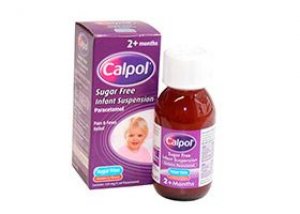
All iLive content is medically reviewed or fact checked to ensure as much factual accuracy as possible.
We have strict sourcing guidelines and only link to reputable media sites, academic research institutions and, whenever possible, medically peer reviewed studies. Note that the numbers in parentheses ([1], [2], etc.) are clickable links to these studies.
If you feel that any of our content is inaccurate, out-of-date, or otherwise questionable, please select it and press Ctrl + Enter.
Calpol
Medical expert of the article
Last reviewed: 03.07.2025

Calpol is an oral suspension for children. It has a strawberry smell and pink color. The main properties of the drug are analgesic and antipyretic.
ATC classification
Active ingredients
Pharmacological group
Pharmachologic effect
Indications Calpol
It is indicated for children from 3 months (at an earlier age, the medicine can only be prescribed by a doctor) to 6 years. It is used as an antipyretic (for diseases such as flu, acute respiratory viral infections, various childhood infectious processes, as well as reactions to vaccines and other conditions in which an increase in temperature is observed), and in addition, a pain reliever (mild or moderate pain syndrome (dental or headaches, as well as muscle pain, neuralgia, as well as pain due to burns and various injuries and damages)).
 [ 1 ]
[ 1 ]
Release form
It is produced in the form of a suspension in glass bottles of 70 or 100 ml. One package contains 1 bottle and a measuring spoon.
 [ 2 ]
[ 2 ]
Pharmacokinetics
After oral administration, peak plasma concentrations are observed after 0.5-1.5 hours. The ratio of bioavailability volumes and distribution of the active component in infants and children is similar to that in adults. The half-life is approximately 1.5-2.5 hours.
The metabolism process occurs in the liver. In patients under 10 years of age, the main breakdown product is paracetamol sulfate, while at the age of 12+ years it is direct glucuronide. In case of glutathione deficiency, these metabolites are able to block the enzymatic hepatocyte systems, causing their necrosis. Then about 85-95% of the drug is excreted in the urine within 24 hours (less than 4% of the dose is unchanged).
Dosing and administration
Take orally with water 1-2 hours after meals, 3-4 times a day. The interval between doses should be at least 4 hours. There is no need to dilute the suspension with water. To make dosing the mixture more convenient and accurate, use a measuring spoon (marks 2.5 and 5 ml).
Single doses for children aged 3 months/1 year – 2.5-5 milliliters of suspension (60-120 milligrams of paracetamol). At the age of 1-6 years – 5-10 milliliters of medicine (120-240 milligrams of paracetamol).
The treatment course usually lasts 3 days (if the drug is used as an antipyretic) or 5 days (if the drug is used as a painkiller). If it is necessary to extend the course, you should consult with your doctor.
Side effects Calpol
Side effects include vomiting with nausea, allergy (such manifestations as itching and rash on the skin, angioedema and urticaria), abdominal pain. In rare cases, leukopenia, thrombocytopenia or neutropenia, as well as anemia, develop. In case of prolonged use in high doses, nephrotoxic and hepatotoxic effects may be observed, as well as the development of methemoglobinemia or panmyelophthisis.
 [ 12 ]
[ 12 ]
Overdose
Signs of overdose: increased sweating, severe pallor, pain in the stomach, and vomiting with nausea. After 1-2 days, symptoms of liver dysfunction begin to appear (pain in this area appears, and the activity of liver enzymes in the blood increases, PT increases). In case of severe overdose, hepatonecrosis and liver failure are observed, and in addition, encephalopathy and coma.
As a therapy: you need to stop taking the medication, perform gastric lavage, drink enterosorbents (such as polyphepan, as well as activated carbon) and administer a special antidote, N-acetylcysteine, intravenously (or you can prescribe oral methionine).
Interactions with other drugs
Alcoholic beverages, tricyclics, barbiturates, antiepileptic drugs, and also rifampicin and phenylbutazone increase the hepatotoxicity of Calpol, and salicylates increase its nephrotoxic effect.
Paracetamol can also enhance the properties of indirect anticoagulants, and in addition, weaken the effect of uricosuric agents and increase the toxicity of chloramphenicol.
Storage conditions
The medicine must be kept in a place closed to children and sunlight. Temperature conditions – no more than 25°C.
 [ 19 ]
[ 19 ]
Shelf life
Calpol is approved for use for 3 years from the date of manufacture of the medicine.
 [ 20 ]
[ 20 ]
Manufacturer
Attention!
To simplify the perception of information, this instruction for use of the drug "Calpol" translated and presented in a special form on the basis of the official instructions for medical use of the drug. Before use read the annotation that came directly to medicines.
Description provided for informational purposes and is not a guide to self-healing. The need for this drug, the purpose of the treatment regimen, methods and dose of the drug is determined solely by the attending physician. Self-medication is dangerous for your health.

